When you want to capture the calm of the ocean or the energy of a sunny shoreline, sketching the beach gives you endless possibilities. You can bring simple shapes like waves, seashells, or palm trees to life, or challenge yourself with more detailed scenes like sunsets, boats, or beachgoers. Beach drawing ideas give you a clear starting point to turn everyday coastal sights into engaging artwork.
You don’t need advanced skills to enjoy the process. Whether you prefer doodling quick sandcastles, practicing shading on rolling waves, or experimenting with textures in the sand, each idea helps you sharpen your technique while keeping the subject fun and approachable. The beach offers both easy and advanced elements to match your style.
By exploring different themes, you can create drawings that feel personal and unique. A quiet shoreline at dawn, a playful surf scene, or even a single seashell can inspire a sketch that reflects your own perspective. With the right ideas, you’ll always have fresh ways to bring the coast into your sketchbook.
Key Takeaways
- Simple and detailed coastal elements provide endless drawing options
- Different approaches let you match ideas to your skill level
- Iconic beach scenes offer inspiration for creating unique artwork
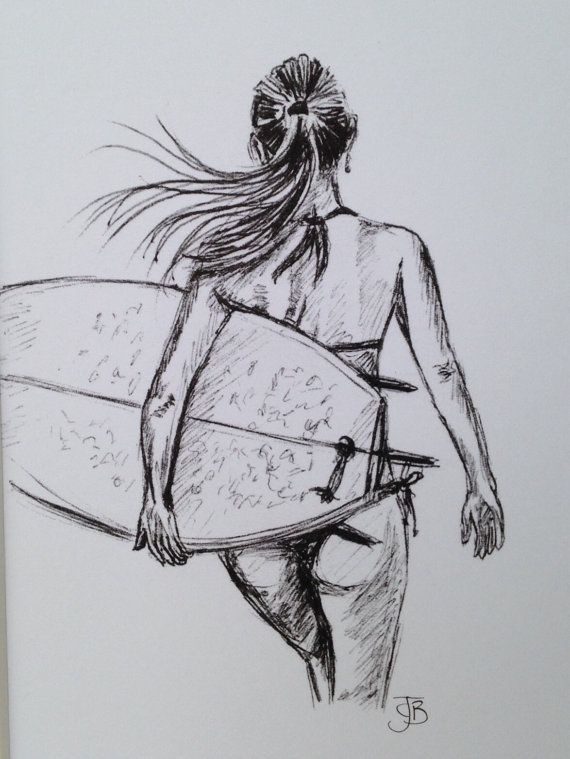

Essential Beach Drawing Ideas
When you explore beach drawing ideas, you focus on details that make seaside sketches recognizable and interesting. Elements like waves, skies, palm trees, and objects on the sand help you create drawings that feel complete and balanced.
Simple Beach Sketches
You can start with the basics by sketching waves, seashells, or a simple shoreline. These drawings don’t require advanced shading and work well for quick practice. A few curved lines can suggest water movement, while circles and spirals capture shells.
Adding a sun in the sky or a small sandcastle gives your sketch more context. You don’t need to over-complicate it—clean outlines and minimal details often look best.
Tips for simple sketches:
- Use light pencil strokes for waves.
- Add texture with short lines for sand.
- Keep the horizon straight to separate sky and water.
These small studies help you improve control and confidence in your beach scenes.
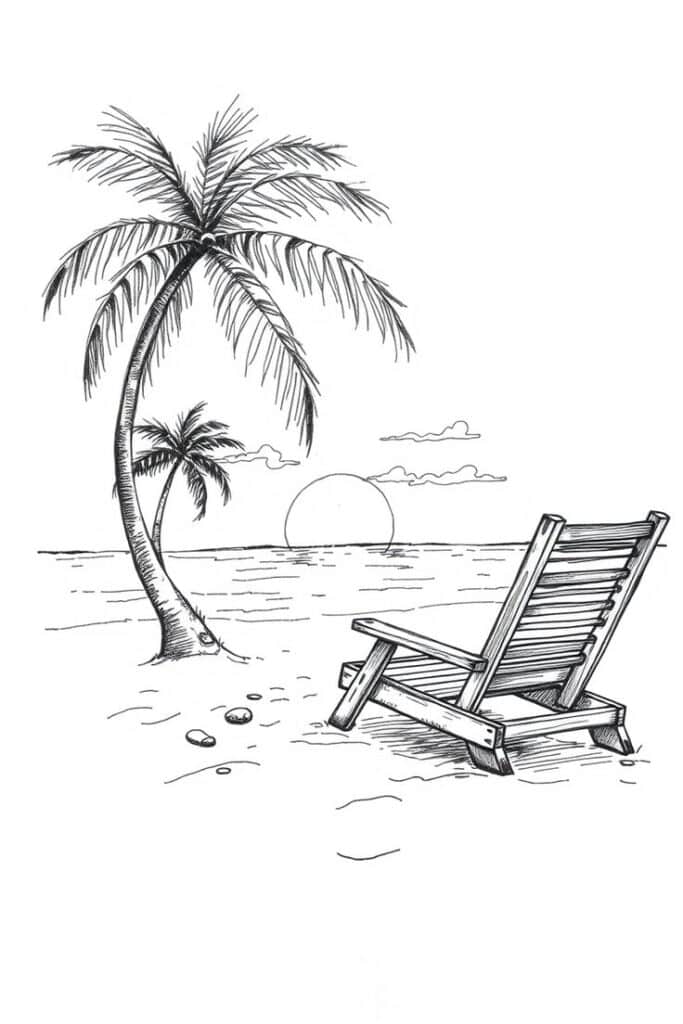
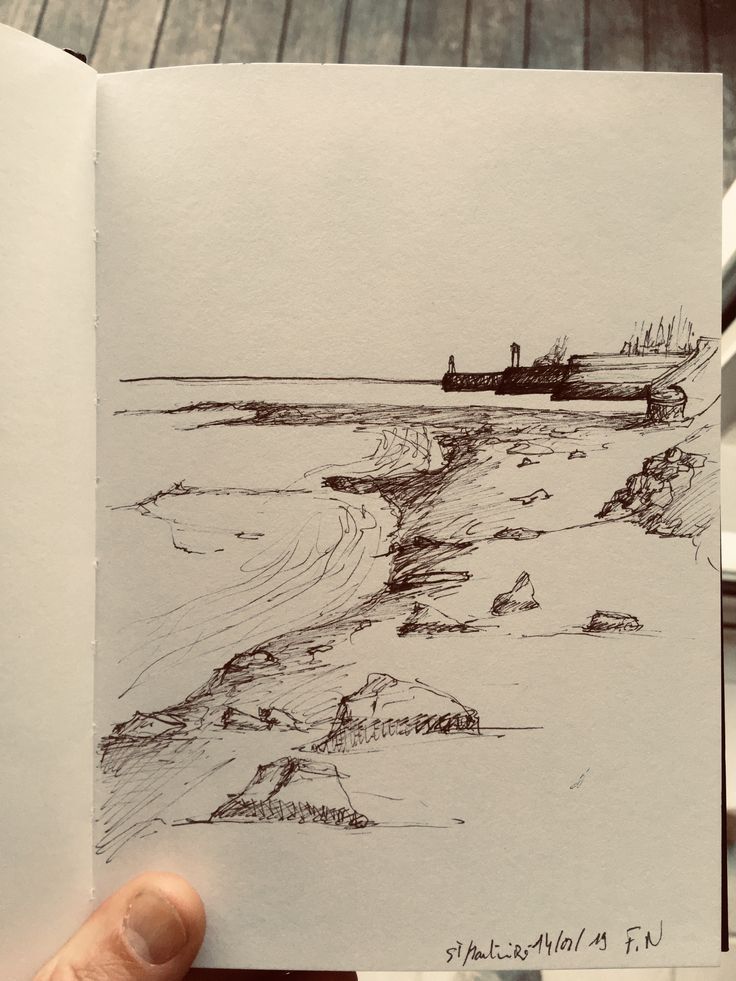
Sunset Beach Scenes
Drawing a sunset over the ocean lets you practice blending colors and gradients. You can show the sun as a circle touching the horizon or half-hidden behind waves. Use soft shading to create the fading light effect across the water.
Reflections are important in this type of beach drawing. Horizontal strokes of orange, pink, or yellow across the water suggest movement and light.
You can also add silhouettes of birds, boats, or palm trees. These dark shapes stand out against the bright sky and give your drawing more depth.
Color choices to consider:
- Warm tones: orange, red, yellow.
- Cool tones: purple, blue, gray.
- Neutral tones: soft beige for sand.
This type of scene works well in both colored pencil and watercolor.
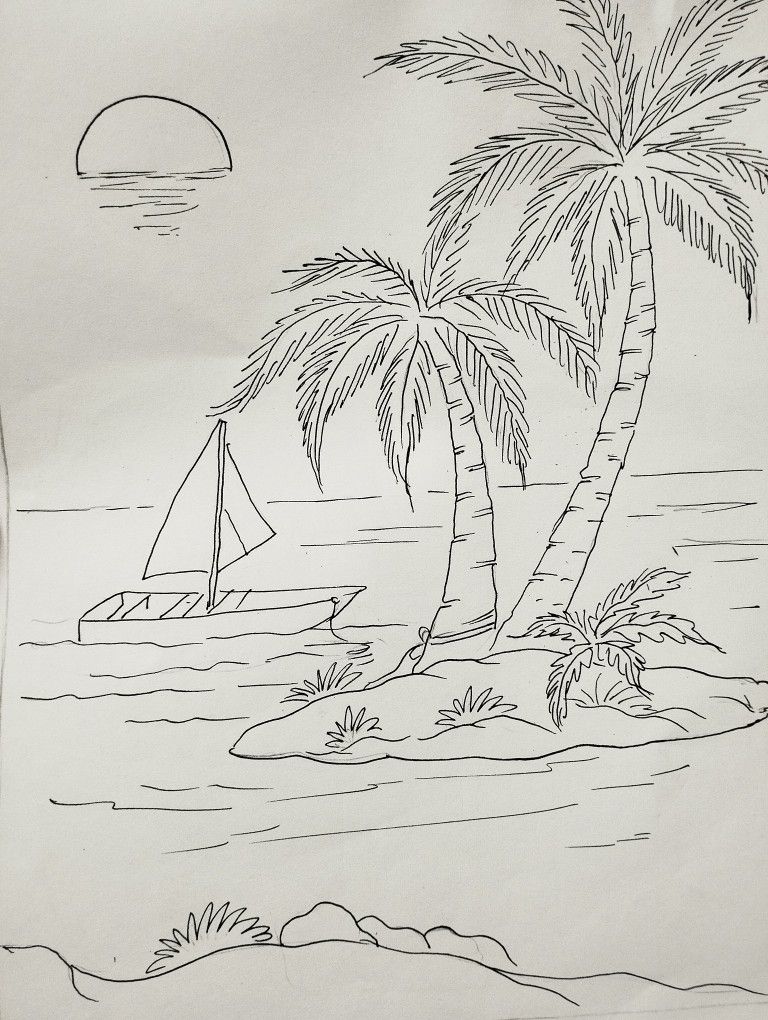

Palm Tree and Shoreline Concepts
Palm trees are an iconic part of many beach scenes. You can draw them with a tall curved trunk and fan-shaped leaves that spread outward. Varying the angle of the leaves makes the tree look more natural.
Shorelines give you a chance to practice perspective. You can draw a curved shoreline that narrows toward the horizon to create depth. Adding small waves or foam lines makes the water edge more convincing.
Consider placing multiple palm trees at different distances. This creates balance and helps guide the viewer’s eye across the page.
Quick checklist:
- Curved trunk with slight bends.
- Fronds drawn with long, thin strokes.
- Shoreline that curves or angles for perspective.
Combining these elements builds a more dynamic beach drawing.
Beach Umbrella Compositions
A beach umbrella adds structure and a focal point to your sketch. You can draw it with a wide canopy divided into sections and a simple pole planted in the sand. Striped patterns on the canopy make it visually interesting.
Placing towels, chairs, or a cooler under the umbrella makes the scene feel lived-in. These small details turn a plain drawing into a complete beach composition.
Think about placement when adding an umbrella. If you draw it near the foreground, it looks large and detailed. If you place it near the horizon, it becomes small and simple.
Ideas for umbrella scenes:
- Umbrella with a folding chair.
- Umbrella next to a sandcastle.
- Umbrella casting a shadow across the sand.
This approach lets you practice scale, perspective, and arrangement while keeping the drawing playful and clear.

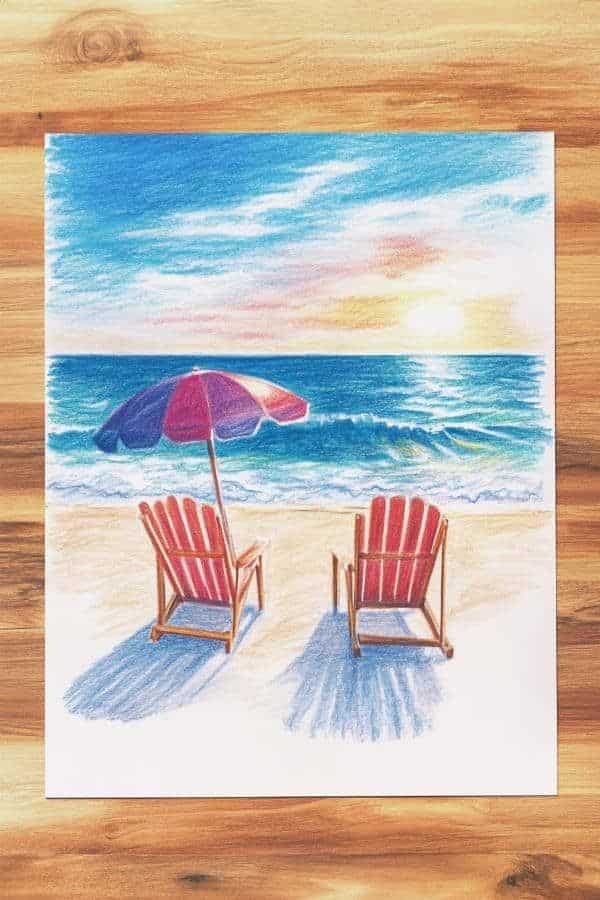
Creative Themes for Beach Artwork
You can capture the beach in many ways, from lively human activity to quiet wildlife and the hidden world beneath the waves. Each theme lets you explore different textures, movements, and details that make beach scenes engaging to draw.
Beach Activities and People
Drawing people at the beach gives your artwork a sense of life and movement. You can sketch children building sandcastles, friends playing volleyball, or families relaxing under umbrellas. These activities add narrative to your beach drawing and make the scene more relatable.
Focus on body posture and simple gestures. A person bending to collect seashells or walking along the shore can be captured with just a few lines. Including accessories like surfboards, beach towels, or sunglasses helps set the context.
Consider using a mix of quick sketches and more detailed studies. For example:
- Dynamic actions: surfing, swimming, running on the sand
- Relaxed moments: sunbathing, reading, napping under shade
- Everyday details: footprints in the sand, kids with buckets and shovels
These elements let you tell small stories within your beach scenes without overcomplicating the composition.

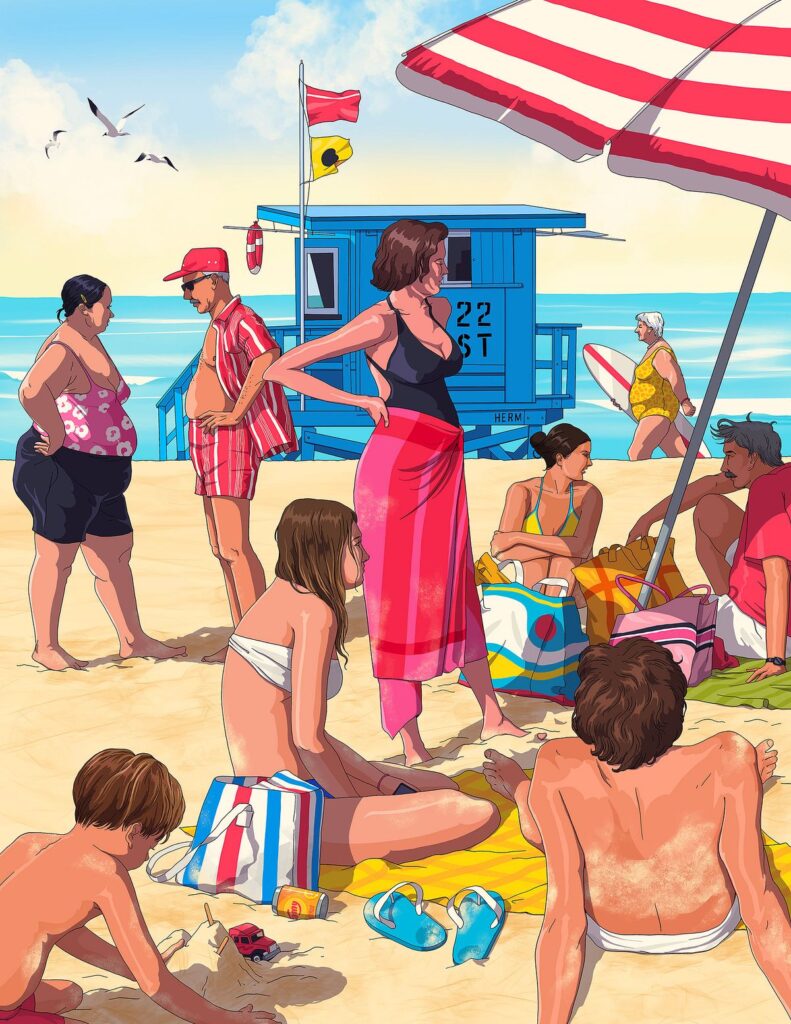
Coastal Wildlife Inspirations
Wildlife adds natural variety to your beach artwork. Birds such as seagulls, pelicans, or sandpipers create lively focal points and show movement across the sky or shoreline. You can also sketch crabs, sea turtles, or starfish along the sand for smaller details.
Pay attention to how animals interact with their environment. A gull perched on driftwood or a turtle heading toward the ocean gives your drawing more depth. Use quick strokes for feathers or shells to suggest texture without needing to overwork the details.
A simple table can help you think about options:
| Wildlife | Setting Idea | Drawing Focus |
|---|---|---|
| Seagull | Flying above waves | Wing motion |
| Crab | Crawling on rocks | Claws and shell |
| Turtle | Nesting on beach | Rounded body form |
These choices bring variety and realism to your coastal scenes.
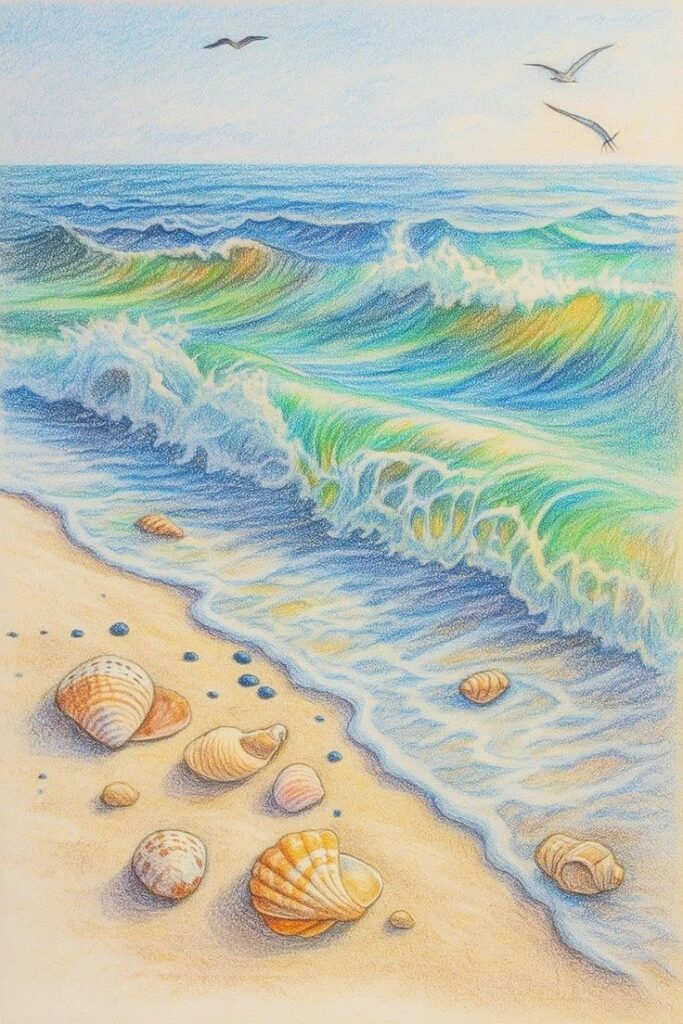
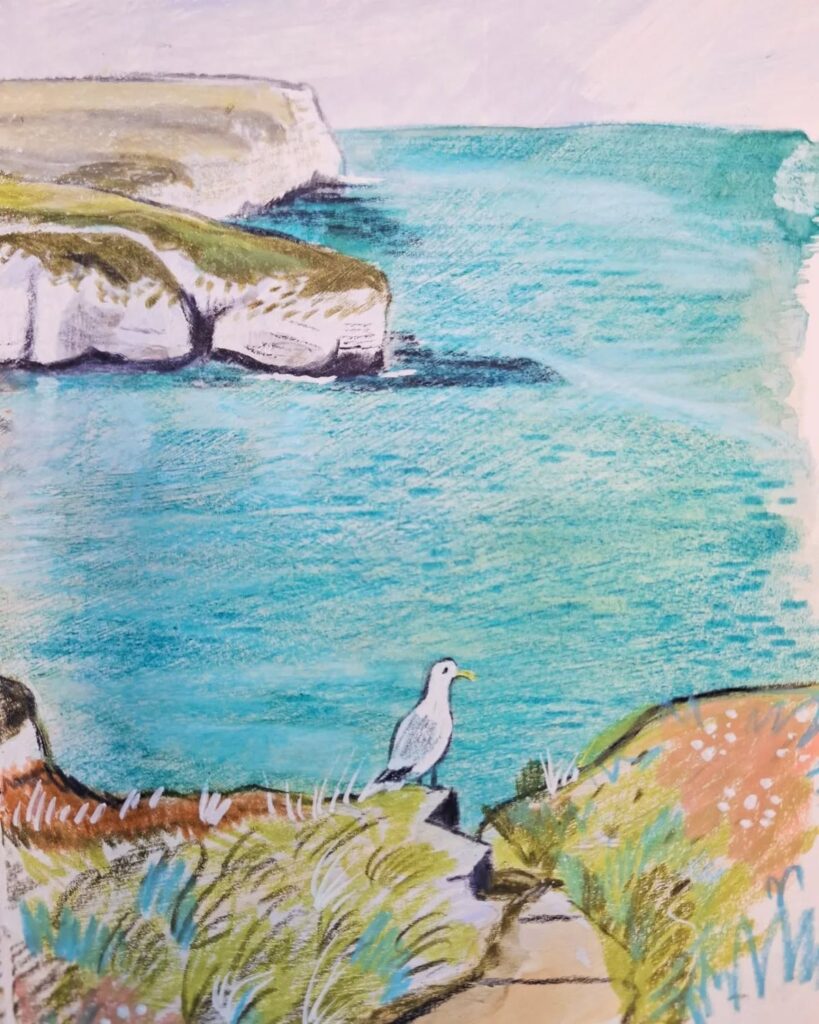
Underwater and Marine Life Drawings
Exploring underwater subjects expands your beach drawing ideas beyond the shoreline. Fish, coral reefs, and sea plants allow you to experiment with shapes and patterns. You can draw schools of fish moving together or a single detailed subject like a jellyfish.
Marine life artwork benefits from contrast and layering. Use overlapping forms to show depth, such as coral in the foreground with fish in the background. Adding bubbles, light rays, or shifting water currents helps create a sense of movement.
Some ideas to try include:
- Colorful coral structures with branching forms
- Sea creatures like dolphins, octopuses, or stingrays
- Small details such as shells, seaweed, and pebbles on the ocean floor
These underwater themes give you more variety in your beach scenes and encourage you to practice different textures, from smooth fish scales to flowing sea plants.
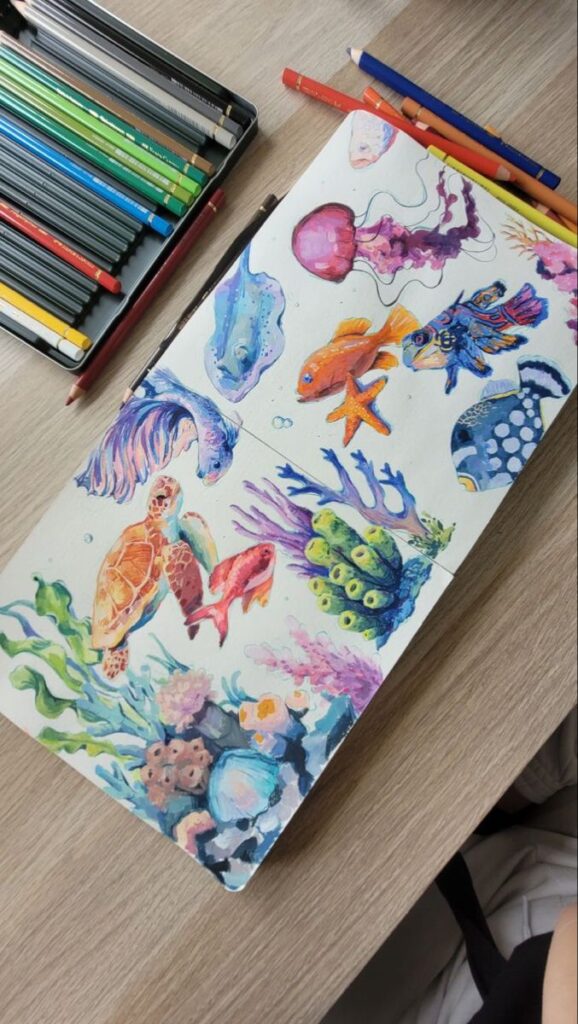

Techniques and Tips for Drawing Beaches
When you create beach artwork, the details matter. The tools you choose, the way you handle color and light, and the techniques you use for sand and water all shape how realistic and engaging your beach drawing feels.
Choosing the Right Tools and Materials
Start with paper that can handle layering. A smooth sketchbook works for pencil sketches, while textured paper is better if you plan to use watercolor or pastels.
For pencils, keep both hard (H) and soft (B) grades. Hard pencils help with light outlines, and soft ones are perfect for shading waves or sand shadows. If you prefer ink, fine liners can capture details like seashells or palm leaves.
Color mediums matter too. Colored pencils give you control for subtle gradients, while watercolors create soft washes for skies and reflections. Markers can add bold accents, but they may limit blending.
Keep a kneaded eraser handy for lifting highlights in water or lightening sandy textures. A blending stump or soft tissue will help smooth transitions between tones.
Using Color and Light for Realism
Pay attention to how sunlight changes throughout the day. Morning light casts cooler tones, while late afternoon brings warmer hues. Try mixing yellows and soft oranges for sand under the sun, and cooler blues for shaded areas.
Water reflects the sky, so match your ocean colors to the atmosphere above. A bright midday sky calls for turquoise water, while a sunset scene may shift the sea toward purples and deep reds.
Use layering to capture variation. Apply light washes first, then build depth with darker tones. For highlights, leave areas of paper uncolored or lift pigment with a clean brush.
To suggest wet surfaces, add small white highlights with a gel pen or leave fine gaps in your coloring. This simple touch makes waves and reflections look more natural.
Creating Depth and Texture in Sand and Water
Depth comes from perspective. Draw a clear horizon line to separate sky from sea, then make waves smaller and closer together as they recede. This creates distance in your beach drawing.
For sand, use short, uneven strokes to suggest texture. Mixing light browns with touches of gray or yellow prevents the surface from looking flat. You can also speckle with a fine-tip pen to mimic grains.
Water texture relies on movement. Sketch gentle curves for calm seas, or sharper, broken lines for choppy waves. Layer different shades of blue and green, blending softly where water meets the shore.
Add small details like footprints, shells, or foam edges to make your beach artwork more lively. These subtle elements bring balance between realism and creativity.
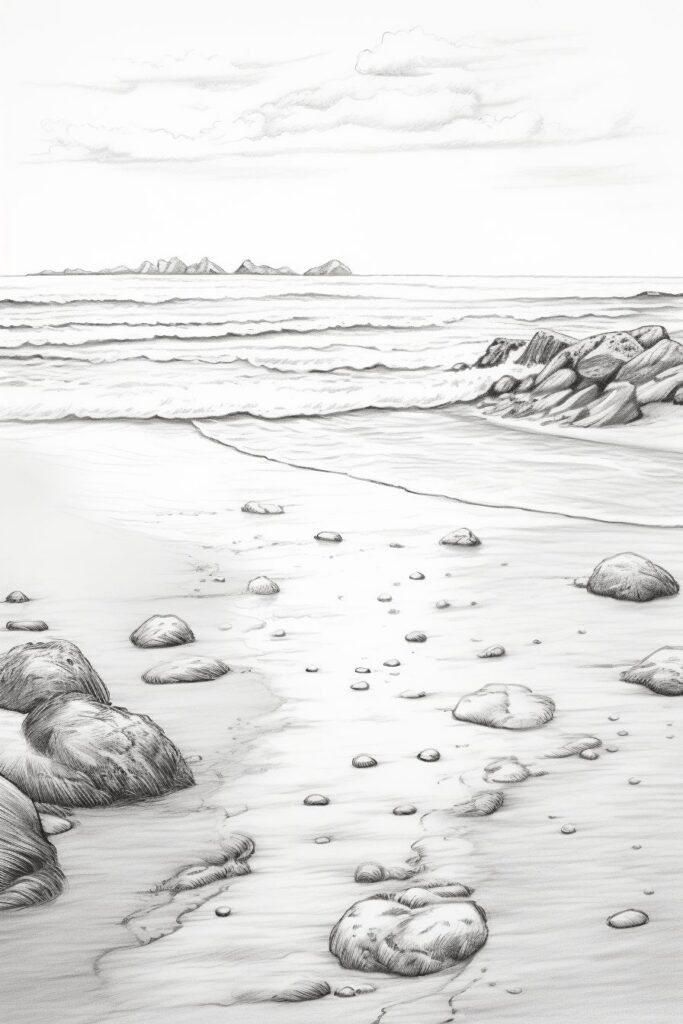
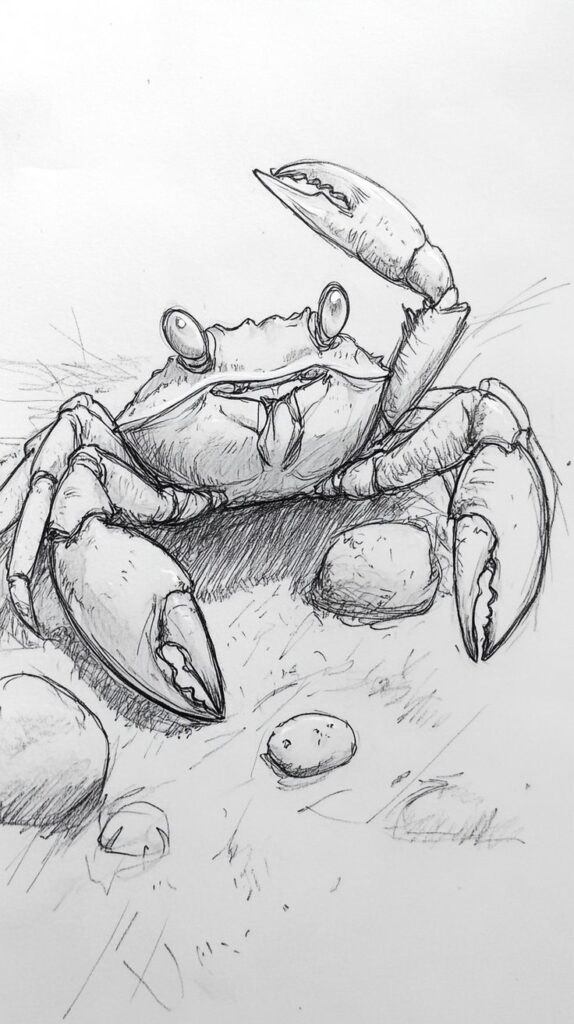
Beach Drawing Ideas for Different Skill Levels
You can approach beach drawing in many ways depending on your experience. Simple outlines work well for beginners, while more detailed textures and perspectives challenge intermediate and advanced artists.
Beginner-Friendly Approaches
Start with basic shapes that capture the beach atmosphere without overwhelming detail. A round sun, wavy lines for the ocean, and a triangle for a sailboat already create a recognizable scene.
You can also try drawing sandcastles, seashells, or palm trees using simple outlines. These subjects let you practice proportion and spacing while keeping the process fun.
For kids or new artists, using step-by-step guides or printable templates can help. Tracing first and then sketching freehand builds confidence. Keep your tools simple—pencil, eraser, and paper are enough.
A good exercise is drawing the same beach scene at different times of day. For example:
- Morning: light waves and empty sand
- Afternoon: umbrellas and footprints
- Evening: a simple sunset with horizon lines
This helps you practice variation without needing advanced skills.


Intermediate Challenges
Once you feel comfortable, focus on adding depth and texture. Try shading waves to show movement or layering lines for sand patterns. You’ll notice how small details make your drawings feel more realistic.
Perspective becomes important at this stage. Drawing a boardwalk leading to the beach or umbrellas receding into the distance helps you practice vanishing points.
Experiment with different tools such as colored pencils or markers. Adding gradients to the sky or highlighting seashells with color makes your work more vibrant.
You might also try sketching seagulls in flight or people walking along the shore. These elements introduce motion and scale, which challenge your observation skills.
A useful practice is breaking a beach scene into layers:
- Foreground – shells, footprints, or towels
- Middle ground – waves, sandcastles, or people
- Background – horizon, boats, or clouds
This structure helps you balance detail across the page.
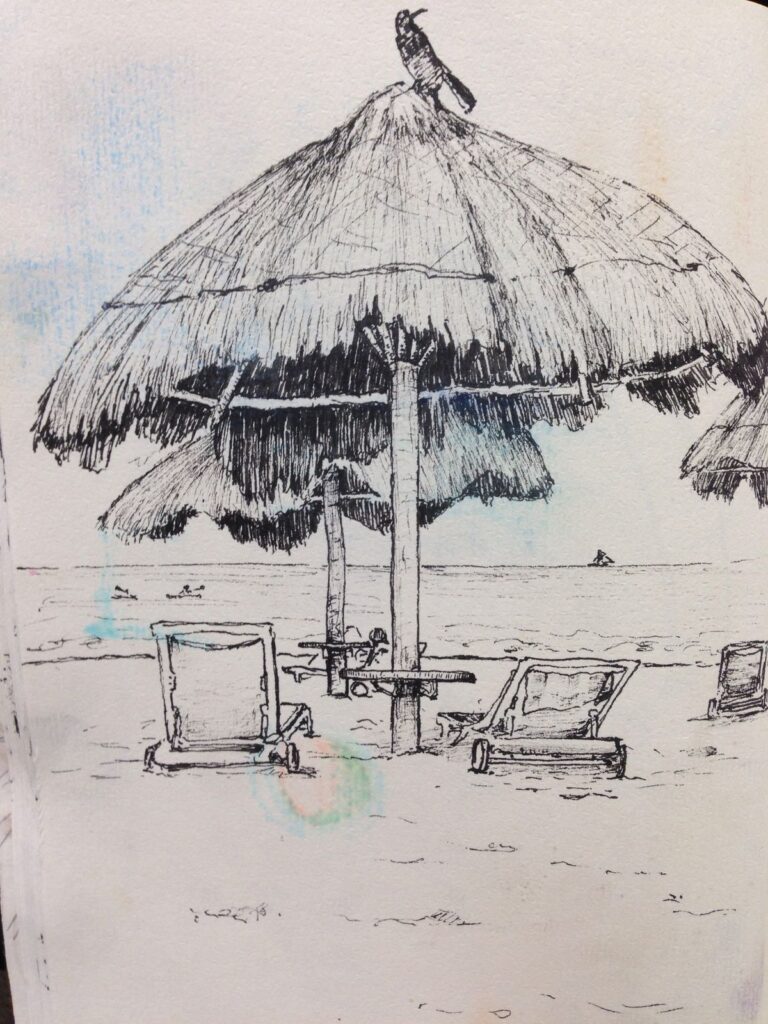
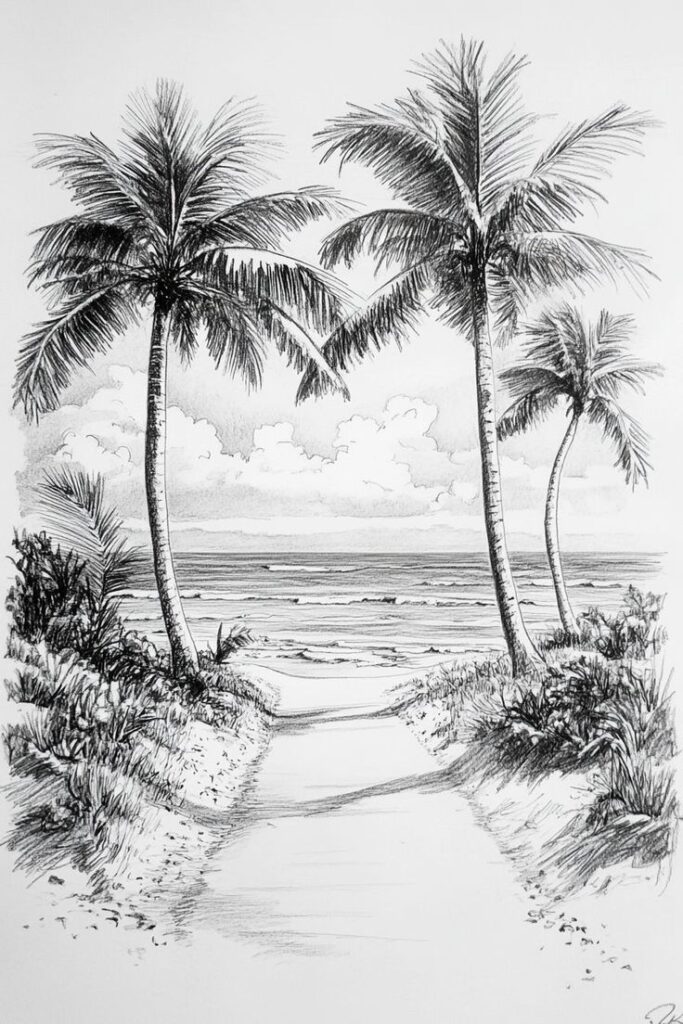
Advanced Artistic Techniques
At an advanced level, focus on capturing realism and atmosphere. You can study how light reflects on wet sand or how foam forms at the edge of waves. These details require patience and careful observation.
Try experimenting with different mediums like watercolor, ink, or digital brushes. For example, watercolor blends work well for sunsets, while ink can emphasize sharp contrasts in rocks or driftwood.
Complex compositions such as stormy seas, crowded beaches, or tropical landscapes push your skills further. You’ll need to manage perspective, texture, and lighting all in one piece.
Consider practicing figure drawing by sketching beachgoers in different poses. Pay attention to posture, shadows, and how clothing interacts with wind.
Another challenge is drawing reflections in water. This requires mirroring shapes accurately while softening lines to mimic ripples. It’s a strong test of both patience and precision.
At this stage, you’re not just drawing objects—you’re building a complete scene that feels natural and balanced.
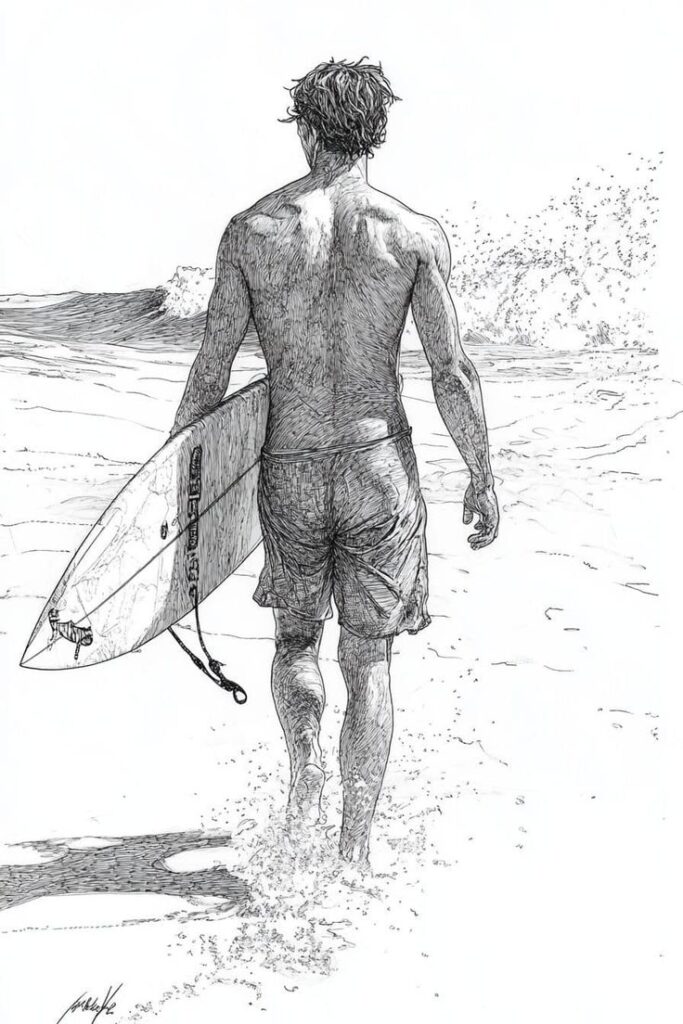
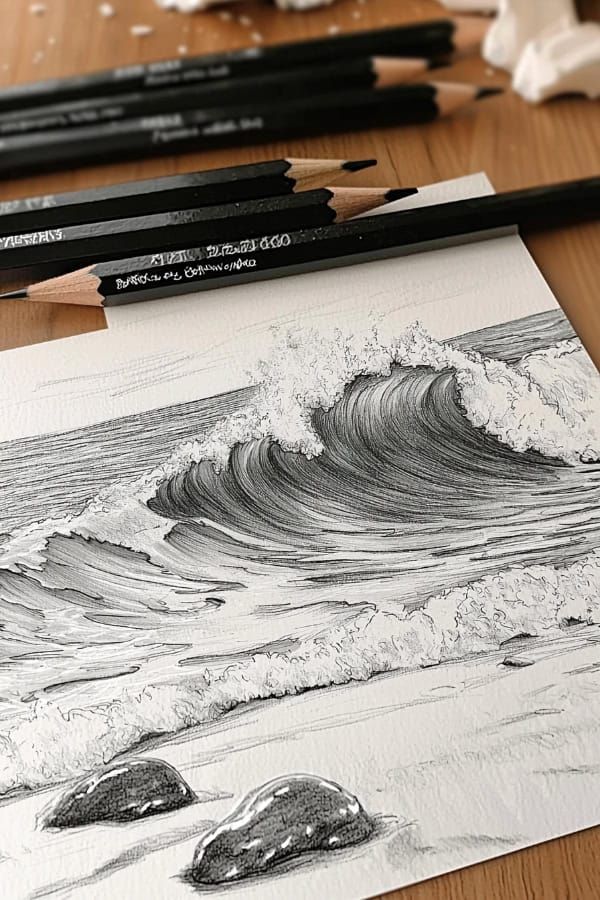
Inspiration from Iconic Beach Scenes
Drawing inspiration from well-known coastlines, seasonal changes, and creative viewpoints helps you add variety and depth to your beach artwork. By focusing on recognizable details and experimenting with perspective, you can create beach scenes that feel more engaging and personal.
Famous Beaches Around the World
You can bring more character to your drawings by studying beaches that are instantly recognizable. For example, Bondi Beach in Australia is known for its wide sandy stretch and surfers riding consistent waves. Capturing the surfboards, lifeguard towers, and bold horizon lines can add strong focal points to your beach artwork.
In contrast, Copacabana in Brazil offers patterned sidewalks, bustling crowds, and vibrant umbrellas. These elements let you practice rhythm and repetition in your sketches. If you prefer something calmer, Santorini’s black sand beaches or Iceland’s Reynisfjara with basalt columns provide unusual textures and tones that stand out from typical golden sands.
When you study these locations, focus on one or two distinct features rather than trying to capture everything. This approach helps you highlight what makes each beach scene unique without overwhelming your page.
Seasonal Beach Landscapes
The look of a coastline changes dramatically with the seasons, giving you endless options for variation. In summer, you might sketch crowded shores with umbrellas, towels, and people enjoying the water. These details emphasize warmth and activity in your beach scenes.
In autumn or winter, beaches often appear quieter and more minimal. You can use muted colors, drifting seaweed, and empty boardwalks to create a calmer mood. Snow-covered dunes in colder regions also make for unusual and striking beach artwork.
Spring brings softer skies, fresh vegetation near the dunes, and lighter tones in the water. Paying attention to seasonal light and weather conditions helps you practice shading and atmosphere in your drawings.
Unique Perspectives and Aerial Views
Changing your viewpoint can completely transform how your beach artwork feels. A bird’s-eye view lets you capture the curves of the shoreline, patterns of waves, and scattered umbrellas from above. This perspective works well when you want to practice symmetry and layout.
You can also draw from a low angle, focusing on seashells, footprints, or small plants in the sand while the horizon stretches in the background. This makes simple details appear larger and more important in your beach scenes.
Another option is to sketch from slanted or diagonal angles, which can create more dynamic compositions. Experimenting with these perspectives encourages you to see familiar beaches in new ways and adds variety to your portfolio.
- 0shares
- Facebook0
- Pinterest0
- Twitter0



